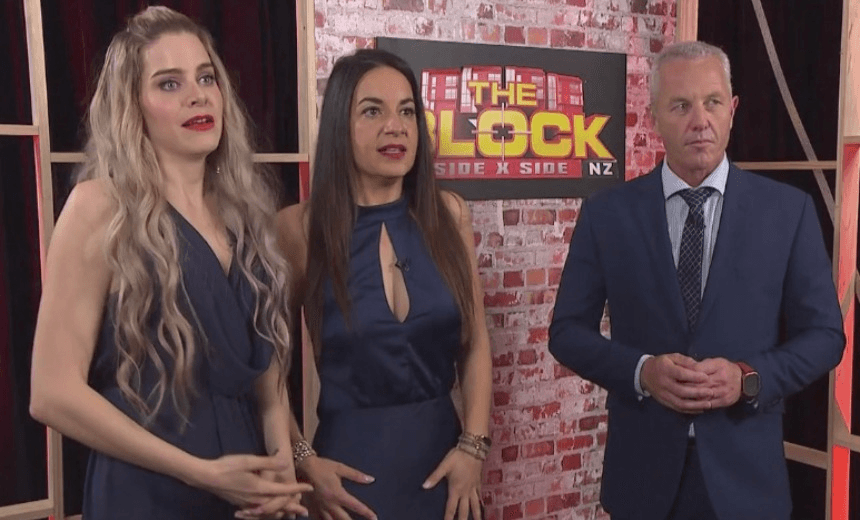Duncan Greive reflects on the shambolic end to The Block 2017, and what the show has revealed to us about our housing market and crisis over that time.
For the last six years – or two parliamentary terms, if you prefer to measure time in that unit – The Block NZ has been both New Zealand’s most successful reality franchise, and the most illuminating cultural artefact of this era. The show features four teams racing to complete a renovation or build of adjacent houses, with each retaining the profit from the sale, while those who get the largest profit also get a $100,000 cash prize.
For five years the show rode the surging Auckland housing market ever higher. Back in 2012 houses in bourgie Takapuna went for between $789,000 and $961,000 – figures which seem almost quaint today. Gradually the median lifted: it was $983,000 the following year, rocketing to $1,429,000 on moving to Pt Chev in 2014, before posting $1,327,500 and $1,425,000 in Sandringham and Meadowbank respectively.
Every year the show’s contestants profits grew a little fatter, rising like the market from a little over $300,000 combined in year one to peak last year with the four teams splitting a Lotto-like $1,081,000. And, for mystifying reasons which can be known only to the contestants, Mediaworks, the IRD and our legislators, all that money was tax-free.
Which is to say that The Block NZ functioned as a perfect advertisement for our housing market: vastly expensive but only going up; everyone made tonnes of money; no one paid tax. To be fair, it wasn’t all jolly: the contestants slept on mattresses in damp and drafty unfinished homes and worked ridiculous hours in what looked like very unsafe conditions – truly, this reality TV captured our era better than any big budget drama could ever dream of doing.
Until, last night, it all broke down. We’ve been told the market will crash or stall since before 2012, but last night we watched it happen on live TV. It was gruesome viewing. Auctioneers in bright yellow ties, coated in sweat looking out at motionless audiences. We watched three-part tragedies unfolding before our eyes: “Think about what you’re getting here”; “too light to sell at the level team”; “I’m going to pass the property in.”
The final analysis reveals a combined pre-bonus profit of just $65,000 across the four teams and eight contestants, by far the lowest in the show’s history. The cruellest part was watching Stace and Yanita, two absolute sweethearts, win the event, only to have Andy and Nate’s passed-in property re-auctioned and take the prize. It was wrenching television, watching “people not make much money”, as host Shelley Ferguson put it, and no one on screen was in any mood to celebrate.
Except for Mark Richardson. The show’s host has been grinning since day one, and launched into a desperate speech: “Forget what the profit margins are – you guys, by virtue of who you are and how you behave has made this the most successful season in Block history”.
What he was selling was even less popular than the Block houses this year, and the show fizzled to a solemn conclusion, with Richardson telling us that the show would return in 2018.
Only, will it? There were predictable errors here, which is both something inevitable in making live television, and somewhat indicative of a franchise going stale near the end of its natural life (repeat, there are no political parallels).
Most prominently, staging the finale the week of an election now looks naive. The result was preordained when shooting commenced; now the drag race has induced enough uncertainty to have becalmed the market.
With the show over for another year, can it recover from this disaster? It’s been such a ratings juggernaut for Three that it’s hard to see it being abandoned entirely. It frequently beat perennial 25-54 dominator Shortland St this winter, takes up hours each week, and groans with opportunities for commercial exploitation.
Yet competitions require contestants, and while you might be able to contractually allow people to work for months for $500 a piece, as Ling and Zing did this year, it’s hard to imagine anyone TV-worthy looking at that number and thinking they’ll give it a crack next season.
Worse than the timing was the constant push to bigger and bigger houses, which mirrors that of the market as a whole. Our house-size has risen over the past few decades from around 100sqm to closer to 200sqm. But the bigger and richer they are, the less liquid, as we saw last night. The opportunity to go accessible and work on apartments – the houses our young people are told to aspire to now – might be the show’s last hope. A smaller, humbler and more accessible Block in 2018 might not sound like a TV exec’s idea of fun. But maybe it’s what we need.
